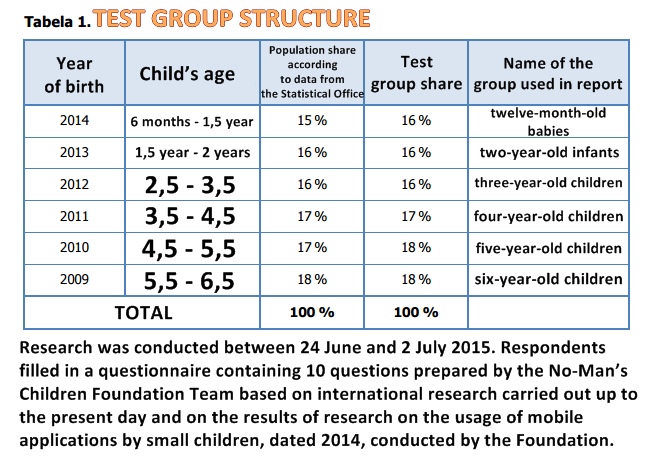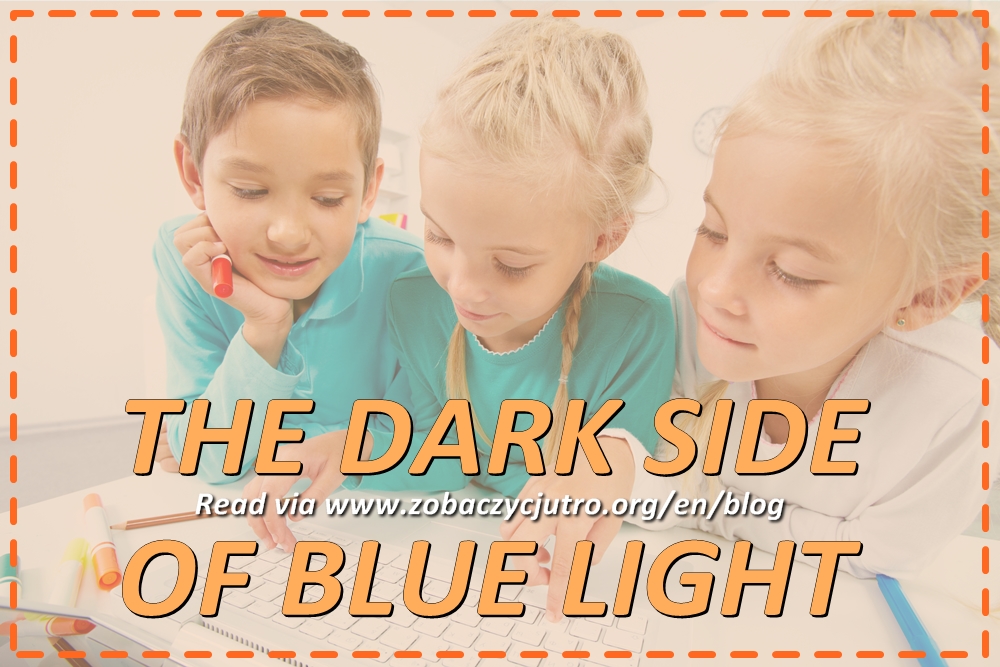DARK SIDE OF BLUE LIGHT |
All this is very encouraging: surfing the net, rummaging about on Facebook, playing online and computer games: Pokémon Go (chasing Pokémon), Minecraft, Angry Birds, and using educational applications… But, is it safe for your child’s eyes? Yes, it is, but in proper doses! Usually, children will spend too many hours in front of screens and very often after finishing their daily adventure with their favourite tablet, smartphone or PC they will complain about eye redness, irritation, eye tiredness as well as headaches, fuzzy vision and even difficulties in falling asleep (in extreme cases – sleeplessness).
DARK SIDE OF BLUE LIGHT
In 2015 The Nobody’s Children Foundation (currently: Empowering Children Foundation) conducted research based on an online survey: “Usage of mobile devices by small children in Poland”. The results are as follows: out of a group of 2,392 persons of age 18 and above having children aged from 6 months to 6 and a half years old, 1011 complete questionnaires were received (performance of a trial degree at the level of 59%):

DARK SIDE OF BLUE LIGHT
Text from the description: Research was conducted between 24 June and 2 July 2015. Respondents filled in a questionnaire containing 10 questions prepared by the Nobody’s Children Foundation Team based on international research carried out up to the present day and on the results of research on the usage of mobile applications by small children, dated 2014, conducted by the Foundation.
The data speaks for itself. Below we list the most important test results:
DARK SIDE OF BLUE LIGHT
1. What problems concerning the optic system appear most often in children of school age?
Accommodative spasm, eye tiredness, headaches and myopia – more and more children and teenagers experiencing these problems are seeking help from ophthalmologists. It is estimated that every fourth teenager suffers from myopia. More and more young people have to wear minus glasses in order to see normally. Sufferers of myopia are wearing stronger and stronger glasses (with thicker lenses). The main cause of these problems is the popularisation of small electronic devices – smartphones and tablets.
Accompanying symptoms may also be: tiredness (tension) of the neck and arm muscles and hyperirritability.
DARK SIDE OF BLUE LIGHT
2. What is accommodative spasm?
It is a situation in which the eye is accustomed to looking at objects close up and is not able to adjust to looking at things in the distance. A person when looking at something in the distance after a Facebook session finds it hard or impossible to see clearly. If a routine eyesight check were to be done right after coming off the laptop it would show that the person was myopic and in order to see properly needed corrective glasses.
Staring at a monitor from a short distance contributes to the increase of tension within the eye muscles, and this is only one step away from eye tiredness or headaches. It is worth tearing yourself away from the monitor every 30 minutes. Look at things far away and close up. This kind of exercise will stave off accommodative spasm.
In the case of hyperopia the effort of the accommodative muscle causes accommodative spasm leading to a situation in which the hyperopic eye becomes functionally myopic – this is so-called apparent myopia.
3. What other afflictions can be caused by staring at a monitor for a long time?
Computer vision syndrome, VDT syndrome (computer monitors) and technostress ophthalmopathy. These concern mainly adults who use electronic devices at work.
4. Can myopia (lat. miopia) and astigmatism (distorted vision) appear in children?
Yes, but usually in older children: 6- and 7-year-olds.It is said that in 1/3 of cases genetic factors are the cause of myopia and in 2/3 of cases: the external background which is vision overload by “working close up” (like reading, painting, using mobile device/laptop/tablet etc.).
DARK SIDE OF BLUE LIGHT
P.S. On the other hand HYPEROPIA occurs mostly in children under 6. For children up to 3 years old it has a physiological character, and all children have better distance vision than close-up vision (ang. hypermetropia, hyperopia).
5. What is the most popular activity of children while using mobile devices?

6. Do outdoor activities affect the development of the optic system?
Yes! Exposure to daylight during the growth period promotes the proper development of the eyeballs. It is scientifically proven. Have your child play sports and all kinds of outdoor activities from an early age.
DARK SIDE OF BLUE LIGHT

7. How to explain to a parent that their child’s access to mobile devices should be limited?
Using strong arguments
PARENT: “It’s such great fun for my child. Such a pity to tear them away from the screen. In addition to this I do not have enough patience to constantly control how much time they spend with their favourite toy… They enjoy themselves without supervision; at least I have some free time for myself!”.
Parents unfortunately don’t help in fighting the problem but expect immediate results and improvement in their child’s vision. Dear Parents and Guardians, it is your responsibility, in great measure, to ensure that your child’s vision is healthy. You must apply time limitations on the usage of digital devices!
DARK SIDE OF BLUE LIGHT
8. What kind of light do electronic devices emit?
Many eye aliments are caused by so-called “high-energy visible light”, also called blue light, which is emitted by the majority of digital devices. Despite the fact that blue light is a natural phenomenon itself – it is similar to daylight and keeps us in stand-by mode – excessive exposure to this kind of light may have a negative affect on our sight and general state of being.
DARK SIDE OF BLUE LIGHT

9. Is there any way to limit the harmful effects of blue light?
The harmful effects can be limited (to a small degree) by glasses with orange lenses. There are also glasses on the market with a so-called nano coating which blocks 30% to 50% of blue light.
Remember! If you like reading e-books it’s best to use an e-book reader which does not emit blue light.
10. What are the daily steps we can take to look after our child’s vision?
Let your child spend no more than 1 hour daily on the computer. Because the child’s vision is developing as they grow up, it is very sensitive to blue light. Children should be accustomed to clearly-defined rules regarding their use of electronic devices! Regardless of mutiny, fits of hysteria or constant requests. Applications with embedded parental controls which adjust time limits upfront may be helpful in implementing the above rules.
DARK SIDE OF BLUE LIGHT
Your vision is exposed to many external factors daily, not only to high energy visible light (blue light) but also to dry air, air conditioning, bad light, lack of sleep, long-term stress, smoking or passive inhalation of cigarette smoke, alcohol and bad diet.
A healthy and hygienic lifestyle, proper diet (rich in vitamins A, E, omega-3 acids, lutein) and physical activity will limit the negative influence of external factors on our vision. Visit our Facebook website regularly – among other things we post recipes for #HealthyVision and exercises which relax overtired eyes.
DARK SIDE OF BLUE LIGHT
 Cartoon icons designed by Freepik
Cartoon icons designed by Freepik
A few words about what we do:
—> At our orthoptic clinic, orthoptic therapy is carried out by, among others, Ewa Młodawska, a registered orthoptist and special educator with long-time experience in child therapy.
—> Our YouTube channel has videos on fusion exercises using orthoptic slat:FUSION EXERCISE

—> Fusion exercises with orthoptic slat aim at regaining part of binocular vision, so-called: fusion.
—> Orthoptic exercises are recommended in any case of dysfunction in the three levels of binocular vision, i.e. simultaneous perception, fusion and stereoscopy.
Please read our extensive post on optodyslexia. Optodyslexia has recently been identified as one of the most common causes of children’s education problems: https://zobaczycjutro.org/optic-dyslexia-optodyslexia/
If you wish to enrol your child for orthoptic exercises, call us on 22 266 09 95 or write to us at biuro@zobaczycjutro.org.




Najnowsze komentarze